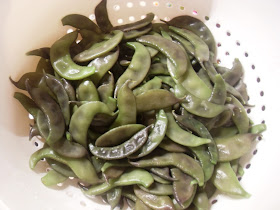Though my family has enjoyed the bountiful harvest of Purple Hyacinth Beans I have stir-fried, they really prefer the English beans (Phaseolus vulgaris) such as “Blue Lake” that you buy fresh, frozen, or canned from the store. The cooking method to make the Purple Hyacinth Bean (Lablab purpureus) taste like an English-type bean is the same as the method I use for Chinese Long Beans, though the Hyacinth beans must be cooked for a shorter amount of time. In short, I blanch them.
 |
| Purple Hyacinth Beans Ready to Cook |
Blanching requires bringing a pot of water to a rolling boil and making the water very briny with a generous amount of salt (at least ¼ cup of salt per 2 quarts of water).
 |
| Add plenty of salt to the boiling water |
Once you have the beans ready and the water boiling, set the timer for 3 minutes and dump in the beans.
Stir the beans after 2 minutes just to make sure both sides of all beans are blanched.
Beans should turn a green color, as shown below.
 |
| Most - but not all - beans will turn some shade of green |
Finally out the beans using a colander and serve with butter or eat plain.
 |
| Not so purple Hyacinth Beans ready to eat |
While some people may scoff at the idea of losing so many minerals in the water or having to prepare so much to blanch the beans, I feel blanching the beans is time well spent to have my children enjoy eating their veggies.


Hi we have that beans too, however we saute it and not just blanch. It has a characteristic scent which i don't like if just blanched, but i know that it is the best way to retain more nutrients.
ReplyDeleteI hope to try these next year along with my Kentucky Wonder pole beans... whatever way you can get kids to eat veggies is great...
ReplyDeleteI love these beans Asian Indians make them with curry. I take a spoon of olive oil add crushed garlic and mustered seeds if u have them handy cook a few sec add one cup of beans cut into half and a cup of potato cubes. add salt, turmeric (very good antiseptic and cold reliever) and a pinch of chili powder and 1 tbs of cumin powder. Cover a cook till potatoes are tender. Add a pinch of sugar and garnish with cilantro leaves. Try this with steamed rice its heavenly
ReplyDeleteThanks for the cooking ideas and recipe, Alpa! I love cumin! That sounds delicious.
DeleteDo you not have to worry about them being poisonous/toxic ???
ReplyDeleteThey become poisonous when the inner seed dries with a black seed covering. Until then, they are completely safe in their immature (green) state. Though you can stir-fry them, I don't care much for the taste - so I prefer to blanch them.
DeleteThey are indeed poisonous. Boil once, drain, boil again eliminates the toxin. Find Indian recipes for safe results.
ReplyDeleteDear Dan,
DeleteThe dry seeds of the Purple Hyacinth Beans are poisonous, but the immature tender green pods are not. They are much like Chinese Long Beans in taste, but with a little bit of a fuzzy texture to the seed pod - kind of like soybean seed pods.
There are no tender green pods as u state,they are purple.as I'm looking at them,the baby beans are purple also,the back been doesn't develope till the pod is relatively mature
DeleteHello and welcome to the ScientificGardener blog. So, when I mentioned a "green" state earlier this refers to immature. This is similar to when a child breaking an arm is termed a "green" break because it has yet to have fully developed. Purple hyacinth bean pods begin purple, then turn tan as the seeds dry and develop. However, cooking them will make the pods green.
DeleteBest wishes & Happy Gardening!
-Jay
what green pods? mine started out purple and just grew big and fat from there. they are not yet dried on the vine and the beans inside are already huge and black with white tips. so immature is what, less than 2' long and the bigger pods need to be left, let them dry, shell, dry some more then cook twice????
ReplyDeleteHello there and welcome to my little blog.
DeleteYes- they do start out and remain purple until they are either picked and cooked or dry out and become dull. How mature a pod is at the time of harvest is more a factor of how thick the pods are from seeds bulging on the purple bean than from how long the pods have grown. The pods are fine to eat when they are picked young (with smaller immature seeds) but I would not take chances on consuming the dry bean seeds or pods that are near maturity.
May i know why are you adding so much of salt?
ReplyDeleteGreat Blog I'm sharing!
ReplyDeleteI simply grow the plants for their flowers and foliage. The flowers smell divine, and Hummingbirds love the nectar.
ReplyDelete